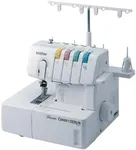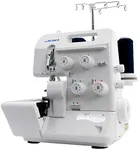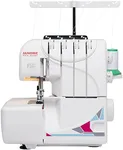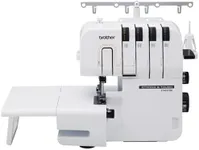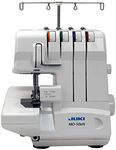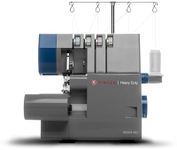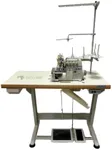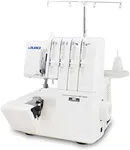Buying Guide for the Best Sergers
When it comes to picking the right serger, it's important to understand your specific needs and how different features can meet those needs. Sergers, also known as overlock machines, are essential for creating professional-looking seams and finishes on your sewing projects. They can handle a variety of fabrics and are great for sewing knits, finishing edges, and creating decorative stitches. To choose the best serger for you, consider the following key specifications and how they align with your sewing goals.Number of ThreadsSergers can use anywhere from 2 to 5 threads. The number of threads determines the types of stitches the machine can create. A 2-thread serger is good for lightweight fabrics and simple edging. A 3-thread serger is versatile for most general sewing tasks and provides a strong seam. A 4-thread serger offers even more durability and is ideal for stretchy fabrics. A 5-thread serger combines overlocking and chain stitching, making it suitable for heavy-duty projects. Choose the number of threads based on the complexity and durability required for your sewing projects.
Differential FeedDifferential feed is a feature that allows you to adjust the speed at which the fabric is fed through the machine. This is important for preventing stretching or puckering, especially when working with stretchy or delicate fabrics. Sergers with adjustable differential feed can handle a wider range of fabrics and provide more professional results. If you plan to work with various fabric types, look for a serger with this feature.
Stitch Width and LengthThe ability to adjust stitch width and length gives you more control over the final appearance of your seams. Wider stitches are useful for thicker fabrics and decorative edges, while narrower stitches are better for lightweight fabrics and fine finishes. Adjustable stitch length allows you to create longer stitches for basting or shorter stitches for more secure seams. Consider a serger with adjustable stitch width and length if you want versatility in your sewing projects.
Ease of ThreadingThreading a serger can be complex, especially for beginners. Some sergers come with features like color-coded threading paths, automatic threading, or lay-in threading systems to make the process easier. If you are new to using a serger or prefer a more user-friendly experience, look for a model with these threading aids.
Built-in Rolled HemA built-in rolled hem feature allows you to create narrow, professional-looking hems quickly and easily. This is particularly useful for finishing edges on lightweight fabrics like chiffon or silk. If you frequently work with delicate fabrics or want to add a polished touch to your projects, consider a serger with a built-in rolled hem function.
Free ArmA free arm serger allows you to sew small, tubular items like sleeves, cuffs, and hems more easily. This feature is particularly useful for garment construction and alterations. If you plan to sew a lot of clothing or small items, a serger with a free arm will provide greater convenience and flexibility.
Speed ControlSpeed control allows you to adjust the sewing speed of the serger. This is important for beginners who may need to sew more slowly to maintain control, as well as for experienced users who want to sew quickly. If you value having control over your sewing pace, look for a serger with adjustable speed settings.
